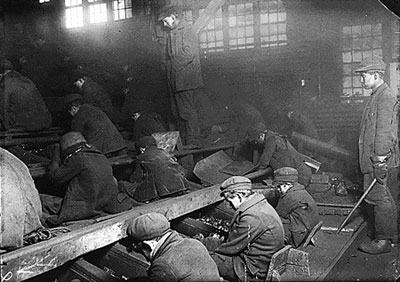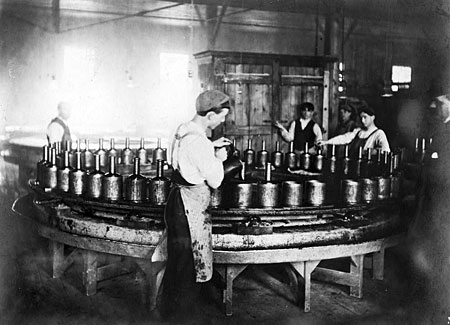Child Labor (continued)
 Women and children working in factories |
Lowell, Massachusetts was known for its early cotton mills. Girls as young as ten years old worked from five o’clock in the morning until after seven o’clock in the evening. They lived at the mill and went home to their families two to four months out of the year. They were paid about two dollars each week. Workers were given a half hour to eat in the morning and a half hour to eat in the afternoon. Most of the work was simple. Young girls were given jobs such as replacing empty bobbins with full bobbins. The children did not go to formal school.
Harriet Hanson Robinson, the wife of a newspaper editor, wrote her autobiography that provided an account of her earlier life as a female factory worker.
Help was in great demand and stories were told all over the country of the new factory place, and the high wages that were offered to all classes of work¬people; stories that reached the ears of mechanics' and farmers' sons and gave new life to lonely and dependent women in distant towns and farmhouses… Troops of young girls came from different parts of New England, and from Canada, and men were employed to collect them at so much a head, and deliver them at the factories.
Those of the mill girls who had homes generally worked from eight to ten months in the year; the rest of the time was spent with parents or friends. A few taught school during the summer months. Their life in the factory was made pleasant to them. In those days there was no need of advocating the doctrine of the proper relation between employer and employed. Help was too valuable to be ill-treated…
The most prevailing incentive to labor was to secure the means of education for some male member of the family. To make a gentleman of a brother or a son, to give him a college education, was the dominant thought in the minds of a great many of the better class of mill girls. I have known more than one to give every cent of her wages, month after month, to her brother, that he might get the education necessary to enter some profession. I have known a mother to work years in this way for her boy. I have known women to educate young men by their earnings, who were not sons or relatives. There are many men now living who were helped to an education by the wages of the early mill girls.
It is well to digress here a little, and speak of the influence the possession of money had on the characters of some of these women. We can hardly realize what a change the cotton factory made in the status of the working women. Hitherto woman had always been a money-saving, rather than a money-earning, member of the community. Her labor could command but small return. If she worked out as servant, or "help," her wages were from 50 cents to $1.00 a week; or, if she went from house to house by the day to spin and weave, or do tailoress work, she could get but 75 cents a week and her meals. As teacher, her services were not in demand, and the arts, the professions, and even the trades and industries, were nearly all closed to her.
Children also worked in steel mills. Steel mills used coal power and were very smoky and hot. Carbon monoxide vapors from burning coal were not healthy to breathe on a daily basis. The workers also manipulated dangerous liquid metal. Many of the child workers stayed at the mill 14 hours each day with one day off each week.
 Young boys working in a factory |
Many states were forced to pass child labor laws to set a minimum working age and a maximum workday, but many employers ignored the laws and many of the children worked to help their families. Congress passed a law granting government employees an eight hour workday but it did not affect private industry.
 Young boys in a wax factory |